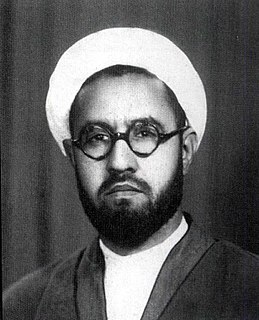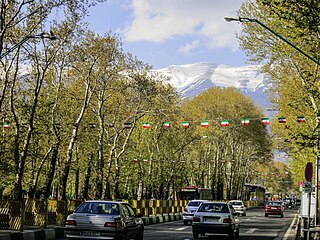
Valiasr Street or Pahlavi Street is a tree-lined street in Tehran, Iran, dividing the metropolis into western and eastern parts built in 1922 to 1927, considering the end of asphalt plan it ended in 1933. It is considered one of Tehran's main thoroughfares and commercial centres. It is also the longest street in the Middle East, and was reported as one of the longest in the world by former BBC journalist Rageh Omaar during the television documentary Welcome to Tehran.
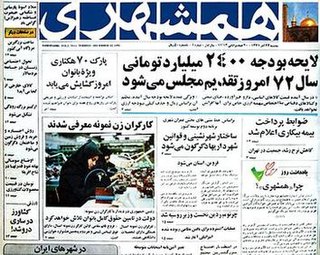
Hamshahri is a major national Iranian Persian-language newspaper.
Seyyed Ebrahim Nabavi is a prolific Iranian satirist, writer, diarist, and researcher of Azerbaijani ancestry. He currently writes in the news website Gooya and the online newspaper Rooz, and has a satirical program for the website and broadcasts on the Amsterdam based Radio Zamaneh.

Shahrak-e Gharb or Qarb Town, also known as Qods Town, is a planned town built as a massive project of modern apartment buildings and villas in the north-western part of Tehran, Iran.

Pasdaran is a neighborhood of northern Tehran centered on Pasdaran Avenue. This avenue connects Niavaran avenue to Shariati avenue. It is about 8–9 km long and is a major commercial thoroughfare for northern Tehran together with northern parts of two other long streets: Valiasr Street and Shariati Street.

Farmanieh is a district located in Shemiran, Tehran, Iran centered on Farmanieh Street. Farmanieh neighborhood extends south all the way to Sadr Expressway, where it becomes Dibaji, and as far north as Niavaran Expressway. It has one of, if not the highest household income rates in Tehran, being home to many embassies, nobles and notables of Iran.
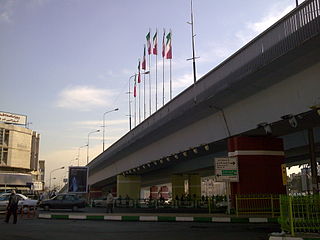
Seyed Khandan is a locality of the city of Tehran in Iran. It is the junction of Shariati Street and Resalat Highway. It is near Resalat district.

Narmak is a neighbourhood in north-east Tehran, the capital of Iran.
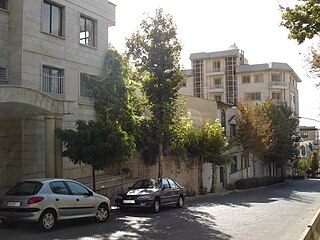
Zafaraniyeh is an affluent neighbourhood in the north of Tehran, Iran. The name's origin lies in the fact that it was the residence of many saffron traders long ago, thus the name Zafaraniyeh. The Islamic Azad University of Tehran, Languages branch is located at the beginning of Zafaraniyeh that teaches English, German, French, Spanish, and other foreign languages. The museum of Sa'dabad Palace is situated at the end of this street, which also contains a culture house. There are plans to build a shopping center in Asef crossroad. The Moghaddas Ardebili Street connects Zafaraniyeh to Velenjak from east and to Valiasr Street and Elahieh from west. Zafaraniyeh is one of Teheran´s safest and most heavily guarded neighborhood due to the many Embassies, Ambassadorial residences and Iranian’s head of state who reside here. There is also a synagogue in this neighbourhood. The area is classed as being the best and most expensive area of Tehran, with many wealthy Iranians and non-Iranians living here. The area has many Billionaires and Millionaires and many of the residents also live abroad. The area consists of nearly all apartment blocks with only a few houses. It is near the longest city road in Asia, Vali-asr Street. This area of Vali-asr street has many boutiques that has shops such as Gucci, Rolex and Armani, Louis Vuitton etc. boutiques. Some of the great Zafaraniyeh Shopping Malls and Centers are listed below:

Park e Shahr, literally the City Park, with its 26 hectares, is a major park located in the region 12th, central Tehran, Iran. It is surrounded by Fayaz Bakhsh Street from the north, Hafez Street from the west, Behesht Street from the south and Khayyam Street from the east.
Ekhtiyariyeh is a neighborhood in the district of Shemiran in northern Tehran, Iran.
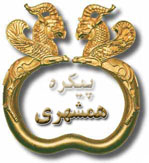
The Hamshahri Corpus is a sizable Persian corpus based on the Iranian newspaper Hamshahri, one of the first online Persian newspapers in Iran. It was in initially collected and compiled by Ehsan Darrudi at DBRG Group of University of Tehran. Later a team headed by Ale Ahmad built on this corpus and created the first Persian Text Collection suitable for information retrieval evaluation tasks.

Enghelab Metro Station is a station of Tehran Metro Line 4. It is located in Enghelab Square, the junctions of Azadi Street, Enqelab Street and Kargar Street. It is between Teatr-e Shahr Metro Station and Tohid Metro Station.

Alborz Province is one of the 31 provinces of Iran, centered in Karaj.

The Islamic Azad University, Central Tehran Branch is a private research university located in Tehran, Iran. Founded in 1982, Central Tehran is the flagship institution of the universities affiliated with the Islamic Azad University system. The university is the oldest, the largest and the top university among all branches of Islamic Azad University academic organization, established in 1982, originally as "Islamic Azad University of Tehran". The university campuses rest on 297,904 m² of various districts of Tehran. It offers approximately 550 undergraduate and graduate degree programs in a wide range of disciplines such as Sciences, Engineering, Art, Architecture, Humanities, Social Sciences and Medical Sciences.

Ostad Moein Station is a station of Tehran Metro Line 4. It is located in Azadi street before Azadi square on junction with Nourbaksh street.

Lar National Park is a protected area in Mazandaran Province and Tehran Province, in northern Iran.
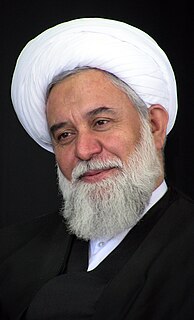
Ali Akbar Rashad is an Iranian philosopher and Islamic scholar who pioneered the Ibtina Theory, a theory for explaining the process and mechanism of "religious knowledge" formation.
Piroozi Metro Station is a station of Tehran Metro Line 4. It is located in Piruzi street.



